
The Top 9 Greatest Tennis Matches of All Time

There have been hundreds of great tennis matches throughout the ages but some of the best come from 2007 onwards. Each of these matches provide something unique and saw the best play to their highest caliber.
These top matches also saw records broken and dynasties shattered while also, at the same time, creating their own legacies, some of which still last to this day. All of these matches have a special flair to them that make them matches you will never tire of watching.
You’ll see common legends like Roger Federer, Rafael Nadal, and Novak Djokovic appear on this list while also seeing other uncommon names such as John Isner and Fernando Verdasco. Nevertheless, every single name here deserves to be on this list.
Let’s get started!
9. Stanislas Wawrinka vs. Novak Djokovic (2015 Roland Garros Final)
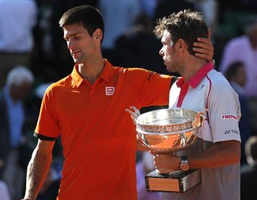 The 2015 Roland Garros final didn’t see the usual King of Clay, Rafael Nadal, face off against whoever his opponent was in the final. Instead, this year was one in which two new contenders—Novak Djokovic and Stanislas Wawrinka—faced off for a historic final.
The 2015 Roland Garros final didn’t see the usual King of Clay, Rafael Nadal, face off against whoever his opponent was in the final. Instead, this year was one in which two new contenders—Novak Djokovic and Stanislas Wawrinka—faced off for a historic final.
The obvious favorite was Novak Djokovic who had taken down two of the big four in the past two rounds. In the quarterfinals, Novak Djokovic dethroned the Spaniard, Nadal, in three shocking sets which no one saw coming.
Then, in the semifinals, his chance of winning his first ever Roland Garros title was tested by the Brit Andy Murray who took him to five sets which Djokovic barely won 6-3, 6-3, 5-7, 5-7, 6-1. With the momentum high and a playstyle that looked like a brick wall, he was the tournament favorite.
On the other side was fellow Swiss cannon, Stanislas Wawrinka, an underdog that was executing and performing at the highest caliber possible. Stanislas Wawrinka took down his Swiss companion, Roger Federer, in a shocking three sets just like how Djokovic did to Nadal.
He then faced off against Jo-Wilfred Tsonga but dismissed with ease. The two were expected to brawl it out but ultimately, Novak Djokovic was expected to come home with his first ever title. After all, going into the finals of Roland Garros, Wawrinka only had one title while Djokovic had eight.
The final started out exciting and in the favor of the Serb after he broke Wawrinka at 3-3 to close out the first set 6-4. But despite the early momentum and the crowd cheering for him, Stanislas was able to turn it around and win the next three sets in close fashion, each coming off of at least one break.
This was when Djokovic was hitting some of the biggest forehands in his clay court career while Stanislas was playing vintage with huge down-the-line one-handers and forehands. The Swiss ultimately prevailed in his display of skill and was able to capture his first and only Roland Garros title.
However, there’s more to it than that. That was the only Grand Slam that Djokovic failed to capture that year. That year, he had won Australian Open, Wimbledon, and US Open. Stanislas Wawrinka created put up one of the best performances that his career had ever seen and it was the one thing standing in Novak’s way from completing the Calendar Slam, an achievement only two have ever completed.
This is why this match deserves to be on this list. Stanislas Wawrinka kept Novak Djokovic from creating one of the most destructive legacies of all time and further postponed his dominance on clay till next year where he only won Australian Open and Roland Garros.
8. Roger Federer vs. Andy Roddick (2009 Wimbledon Final)
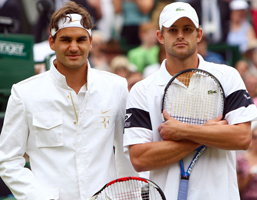 There’s a debate that Andy Roddick would have won several more Grand Slam titles had it not been for Roger Federer, the only player that could stop him. Since 2003, Roger Federer denied Andy Roddick from ever winning another Grand Slam title.
There’s a debate that Andy Roddick would have won several more Grand Slam titles had it not been for Roger Federer, the only player that could stop him. Since 2003, Roger Federer denied Andy Roddick from ever winning another Grand Slam title.
He beat him twice in the Wimbledon final back-to-back in 2004 and 2005 and held his ground again at the U.S. Open in 2006 where he beat Roddick for a US Open title. In 2007 and 2009, Roger beat Andy in the semifinals of the Australian Open but it was at the 2009 Wimbledon final where Roddick tested him.
At the 2009 Wimbledon final, it was looking like an average win for Roger Federer. Andy Roddick was coming off of a five-set win over Hewitt and a four-set win over Murray. Meanwhile, Roger Federer had beaten the past two competitors in straight sets.
With more energy conserved and a better understanding of the Wimbledon surroundings, the match was expected to be highly in Federer’s favor but it soon turned out that Andy Roddick had the upper hand from the start.
He won the first set 7-5. Then, in the second set, the two went to a tiebreaker and Roddick accumulated a 5-1 lead. He extended that to 6-2. With four set points for Roddick, one point in his favor would mean a two set to love advantage and one step closer to taking down Roger Federer for the first time at a Grand Slam.
Roger Federer managed to bring the score up to 5-6 but Roddick still had one shot left. Roddick quickly went on the offensive and pushed to net. With Federer on the run and a high shot for Roddick to put away, the second set was basically converting over to the American.
But Roddick missed the volley, tying the score to 6-6 and this eventually led to Roger winning the set at an 8-6 score, tying the sets at one all. From here, the match went to yet another tiebreaker in which Roger Federer barely edged out 7-5.
Andy Roddick would quickly bounce back with an easy fourth set 6-3 win. In this set, he showed the crowd that he wasn’t out of the running just yet, that he was still in it to win it. His serves were at the prime level he was known for and he was playing just as good from the baseline.
The fifth set ultimately went the distance and totaled thirty games. Both players went back and forth with their own shots at the championship. But ultimately, an unexpected slice return from Federer and a shank from Andy Roddick at 14-15 for Roddick on serve sealed the deal for the Swiss maestro, allowing him to win yet another Wimbledon title.
But there was more to it than just the title. Had Federer given up that second set, Roddick would have been up 2-0 in set count from there and if he won the fourth set just like he did, he would have his very own Wimbledon championship.
This would break the winning streak that Federer had over Roddick. It was a test to see whether or not Roger Federer would blink and throughout the entire ordeal, the Swiss superstar stared down the American without an inch of regret.
Roddick’s match versus Roger Federer was the American tennis scene’s last stand and with former professionals watching all over, there’s no doubt that it was a great showing and a powerful curtain call for those previously on the tour.
7. Rafael Nadal vs. Fernando Verdasco (2009 Australian Open SF)
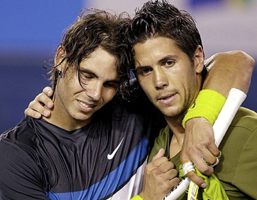 From about 2003 to 2016, the big four of tennis dominated the scene. First, it was Roger Federer and then, it was Rafael Nadal. When Nadal entered the scene, he seemed to be the only person that could actually counteract Roger Federer’s playstyle.
From about 2003 to 2016, the big four of tennis dominated the scene. First, it was Roger Federer and then, it was Rafael Nadal. When Nadal entered the scene, he seemed to be the only person that could actually counteract Roger Federer’s playstyle.
He played some of his best tennis versus the Swiss maestro and they were looking to set up another quality “Fedal” match in the finals. The only player he would have to take down was Fernando Verdasco, a fellow left-handed Spaniard with fairly solid baseline technique.
A little context before this: Nadal had lost in the semis of the AO last year and was looking to redeem himself as he was upset by Jo-Wilfred Tsonga in straight sets at the 2008 tournament. This was his shot and he wasn’t looking to blow it.
But Fernando Verdasco was playing some of the best tennis of his life. Fresh off a win over last year’s Australian Open runner-up—Jo-Wilfred Tsonga—Verdasco was looking to extend the lead and take down Spain’s top talent.
He started out by taking the first set 7-6 (4) over Rafael Nadal in a performance that exceeded his usual talent. He was essentially beating Nadal at his own game from the baseline, taking the ball early, and pushing to the net.
This forced Rafael Nadal to play even better than he usually could and he didn’t disappoint. Despite Verdasco pulling off insanely good shots from the baseline that left the crowd dumbfounded, Nadal did even better.
At 4-5 40-40 on Verdasco’s serve, Nadal survived countless attacks from his Spaniard opponent that left him on the run for 80% of the point. The entire time, Verdasco had the offensive advantage and he was quickly looking to extend it as his attacks improved over time.
Finally, Verdasco hit one of the best slices of his career. It curved down ad line and with Nadal all the way at the deuce side of the court, it looked like Verdasco would be holding his serve to bring it to 5-5 in hopes of another possible tie-breaker.
But Nadal did what he does best and chased down the shot to hit a winner that curved around the net post. Today, that shot is considered a staple of the tennis world: the banana shot. This winner gave him set point which he capitalized to take the second set.
Now at one set a piece, the two went the distance in the third. Despite Nadal grabbing an early break, the third set went to a tiebreaker that Nadal won thanks to strong baseline and consistent ironed-out mental toughness.
The fourth set was not the same. Both players yet again held till another tiebreak but this time, it was Fernando Verdasco who took initiative. Right away, Verdasco went on the offensive, taking Nadal’s shot as early as possible to send them shooting down at angles even Nadal had trouble getting to.
He won the tiebreak 7-1 in a fashion so dominant that even today, it’s considered as one of the most shocking moments in Nadal’s career.
With both players holding two sets each, the fifth and final set would be what determined who would advance to face off against Roger Federer. Yet again, the two went head-to-head, holding from the early stages of the match to the mid-stages of the match.
But it was at the later stage of the fifth set that Fernando visibly began to tire while Nadal began to go on the offensive. Nadal held for a 5-4 lead. With Fernando Verdasco down 30-40, Nadal had his third chance to win the match and he did so off of a double-fault.
An anti-climactic way to win as it does not do the match justice on how exciting and fast-paced the match went. Like Roddick versus Federer, this was one of the biggest matches that determined Nadal’s career.
Every point he won, he had to win with a vigor unlike any other. Every break point he converted and set he won was off of a margin so small that only someone with a strong mental game and even stronger physique could ever match the competition.
This was a perfect display of Nadal’s extreme endurance on the court and he proved that he could do it on any surface he wanted. This was one of, if not, the best brawl-fests we’ve seen from the Spaniard that hasn’t happened on clay and it’s a match every hardcore Nadal fan will remember.
6. Pete Sampras vs. Andre Agassi (2001 US Open QF)
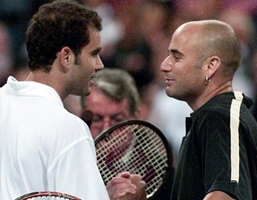 Before the Big Four were a thing, Pete Sampras, Lleyton Hewitt, and Andre Agassi ruled the stage. These three were dominant for a good majority of the time period that they competed in and people always looked forward to the Sampras vs. Agassi matchups.
Before the Big Four were a thing, Pete Sampras, Lleyton Hewitt, and Andre Agassi ruled the stage. These three were dominant for a good majority of the time period that they competed in and people always looked forward to the Sampras vs. Agassi matchups.
These were the Nadal vs. Federer matches of today and they never disappointed. It pitted the best server on the tour, Pete Sampras, versus the best returner, Andre Agassi. It was a display of two drastically different playstyles in a pit of action unlike any other.
The 2001 US Open Quarterfinal is the perfect reenactment of this display of skill. Despite only going four sets, each set went the distance. Neither player lost on their serve throughout the entire match and thus were all decided on tiebreakers.
Pete Sampras was playing his classic playstyle: huge serve followed up with an even better volley. Meanwhile, Andre Agassi was playing vintage Agassi: strong returns and even stronger baseline. One player dominated from the baseline while the other player dominated from the serve.
Despite losing the first set 7-9 in the tiebreaker, Pete Sampras was able to bounce back in the second, third, and fourth set tiebreakers to secure yet another Quarterfinal appearance at the US Open.
This wasn’t just a typical Andre Agassi versus Pete Sampras battle. This was a classic tennis match the showed what tennis was worth, the different playstyles incorporated inside it, and overall, what was in store for the future.
5. Roger Federer vs. Rafael Nadal (2017 Australian Open Final)
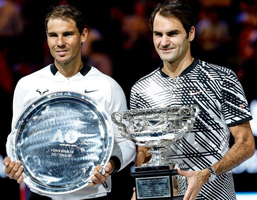 There’s no doubt that the era of the big four is almost over. With Andy Murray nearing retirement and Roger Federer nearing his retirement age, there’s a good chance that within the next three years, we’re only going to see Djokovic and Nadal on the tour.
There’s no doubt that the era of the big four is almost over. With Andy Murray nearing retirement and Roger Federer nearing his retirement age, there’s a good chance that within the next three years, we’re only going to see Djokovic and Nadal on the tour.
However, there was a point where it seemed like more than two of the big four would be leaving the scene and the 2017 Australian Open proved the exact opposite. At this time, Andy Murray and Novak Djokovic were struggling with extremely inconsistent gameplay largely due to their injuries.
Novak Djokovic was struggling with his elbow while with Andy Murray, his hip. The two performed poorly at the tournament. Djokovic lost in the second round while Murray lost in the fourth round. However, this left the two remaining big four players and they weren’t looking to lose.
These two, Nadal and Federer, were struggling to meet the level of competition that mostly Novak Djokovic was providing but with the Serb out, it was their chance to set up a Fedal final and they went the distance.
But both players faced their own competition. Rafael Nadal faced a third-round scare in which he went five sets with Alexander Zverev. He would then face the same problem again versus Grigor Dimitrov who was having a field day on the court.
Federer went through something similar. Roger Federer mostly dominated the first three rounds, losing only one set but in the fourth round, his opponent—Kei Nishikori—pushed him to the limit in which he barely edged past in five sets.
Then, in the semis, he faced fellow Swiss tennis player and former Davis Cup doubles partner, Stanislas Wawrinka. The two battled it out with Wawrinka taking two of the sets 6-1 and 6-4 but Federer ultimately prevailed in the fifth set 6-3.
With both players surviving scares that Djokovic and Murray fell victim two, they set up the perfect Fedal match and one that everyone was looking forward two. The two didn’t disappoint. Despite being some of the oldest players on the tour, both Federer and Nadal put up a performance that no one would forget.
A little context should be told beforehand, though. Because Roger Federer was older than most of the players in the draw, he had to adapt his game, changing it to a more serve-oriented playstyle in exchange for his forehands and backhands.
Meanwhile, Rafael Nadal was struggling overall to play at the level he did beforehand and it was showing even on his favorite court surface, clay.
However, these problems didn’t show up in the final match of the Australian Open. Nadal was playing his dominant playstyle, attacking from the baseline while defending with his huge court coverage. Meanwhile, Roger Federer was putting up his own show by hitting some of the biggest one-handed backhands people had seen in years.
In each set, one or the other dominated. The first set, Roger Federer took with an easy 6-4 win while Rafael Nadal responded with his own 6-3 set. In the third set, Federer took it 6-1 while Nadal did the same 6-3.
Till this final, people thought that Nadal and Federer were out of the run for Grand Slam titles. Sure, they would produce some notable wins but with new talents like Zverev and Edmund approaching and powers like Murray and Djokovic still at bay, no one expected the two former legends to be able to put up a show like this.
After all, from 2011 to 2016, Roger Federer had only won one title and that was at Wimbledon in 2012. This win gave Roger the motivation needed to bring back the era of dominance that he and Rafael Nadal would bring and he proved to the world that they were not only back but they were here to rule.
4. Rafael Nadal vs. Novak Djokovic (2013 Roland Garros Semifinal)
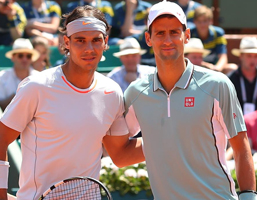 We’ve seen quite a few notable Novak Djokovic vs. Rafael Nadal matches but there’s been none like this one in the context that this was the first time Djokovic poked a hand at Rafael Nadal on his home court and almost won it.
We’ve seen quite a few notable Novak Djokovic vs. Rafael Nadal matches but there’s been none like this one in the context that this was the first time Djokovic poked a hand at Rafael Nadal on his home court and almost won it.
Every year before 2013, Rafael Nadal had taken down Djokovic with little to no ease only dropping one whole set the entire span of time before their first close matchup. Business started off as usual for Rafael Nadal with the Spaniard securing the first set 6-4.
However, the Serb responded with his own set after barely breaking Nadal when he was up 4-3 to take it 6-3. From here, Nadal responded with vintage Nadal, taking him down 6-1 in the third set after firing on all cylinders.
But this didn’t discourage Novak Djokovic. Using his extreme athleticism to hit some of the best angles seen by man, Novak Djokovic literally ran Nadal off the court in every direction possible. This would help him bring the fourth set tiebreaker.
The tiebreaker started out fast in Djokovic’s favor as he came up 3-1 and he would go on to close it 7-3 to grab the fourth set. With two sets both under each player’s belt, the fifth set became the decider and it was quickly evident that this wasn’t going to be a one-sided battle.
Djokovic started out with the lead, grabbing an early break to bring him up 2-0. However, Nadal stayed fast and was able to recover just in time as Djokovic was serving at 4-3 to try to bring himself up 5-3 in the match.
It was here that Nadal was able to edge out a close break game and tie it to 4-4. That’s when the madness began. Both players began to hold serve extremely well and during their service games, both players provided exceptional highlight-worthy shots.
It was at 7-8 though that Djokovic finally began to give out. It was here that the Serb’s endurance was no match for the Spaniard’s. Nadal’s heavy rallies proved too much for Djokovic and he finally relented to Rafa to allow him yet another spot into a Roland Garros final.
This match wasn’t just the first time Novak Djokovic challenged him for the crown of clay court dominance. It was a fine distinction of some of the best hitting in Roland Garros history. Both players were producing extremely strong shots on all spectrums.
There were very few points that ended under three shots. Most of the rallies lasted for ages and was a testimony to both player’s athletic skill. While Nadal was successfully able to defend his throne in 2013, this was the start of a power struggle between the Serb and the Spaniard on clay.
3. Novak Djokovic vs. Rafael Nadal (2012 Australian Open Final)
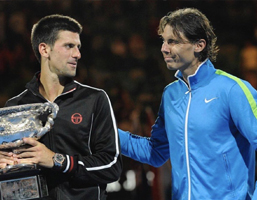 Novak Djokovic challenged Rafael Nadal on his home court but Rafael Nadal did the same in 2012 at the Australian Open where he faced off against the Serb in a final that would define the year that would come afterwards.
Novak Djokovic challenged Rafael Nadal on his home court but Rafael Nadal did the same in 2012 at the Australian Open where he faced off against the Serb in a final that would define the year that would come afterwards.
Both players were coming off of huge wins going into the Australian Open final. Novak Djokovic took down David Ferrer in an extremely solid quarterfinal match and followed up by taking down fellow big four member, Andy Murray, in five close sets.
Meanwhile, on the other side of the bracket, Rafael Nadal took down longtime rival, Tomas Berdych, in four sets in the quarterfinals and followed it up with a crucial semifinal win over Swiss opponent, Roger Federer to grab himself his first AO finals appearance in two years.
In the first set, Nadal came out guns-swinging. After a close ten games, Rafael Nadal finally broke and held to take the first set 7-5, something that Novak Djokovic never saw coming. However, this didn’t deter Novak.
Novak responded with an extremely solid second set. He used his strong serve and even stronger return to dictate both Nadal’s return and his serve and even the Spaniard’s court coverage couldn’t save him at times. Novak would use all of these weapons to eventually close out the set 6-4.
The third set was another Djokovic fest in the beginning. This time, the Serb used his fantastic backhand and deep baseline shots to control the relative momentum of the match in order to bring himself up 3-1. From here, he would dominate for the rest of the match and close it out 6-2.
But Nadal was stepping up his game. He was matching Djokovic on the backhands and his serve and return were finally coming back into play. Utilizing these with his court-coverage, Nadal was too tough to beat in the fourth set.
Despite being down 4-5 and on serve, Nadal held on and eventually edged past Djokovic with a 7-6 (5) win in the fourth. With both players holding two sets, the fifth set would determine the champion and in the beginning, it was looking to be in Nadal’s favor.
Using his unrelenting speed and powerful forehands, Rafael Nadal quickly brought a lead up to 4-2. But Djokovic bounced back and won two games to tie it at 4-4. However, Nadal bounced back and was up 5-4 versus Djokovic.
Djokovic himself responded with an easy hold to bring it to 5-5 where he would display athleticism never seen before by the Serb. He would combine endurance with accuracy and power with touch to finally edge past Rafael Nadal for the first time in the fifth set, just when he needed it the most.
And at 6-5, Djokovic found himself in a predicament as he was down 30-40 with Nadal holding a break point. But the Serb held fast and brought it to deuce. With Novak desperately trying to take him down from the baseline, things paid off.
After saving a break point, Novak quickly converted it to a Championship Point which he won off of a serve plus one to win his third Australian Open, giving him a name among the Australians as one of the best to ever play on their court.
Nadal’s home is at Roland Garros and for Novak, it’s the Australian Open that he loves. He’s dominated on their courts and he does it without fail every year. However, he’s gone through trials to bring himself to this level of dominance and one of the most defining moments in his career was when Nadal almost took his legacy away.
2. Bjorn Borg vs. John McEnroe (1980 Wimbledon Final)
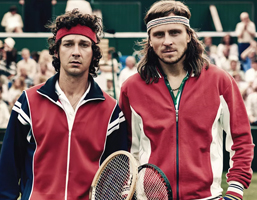 Most of the best matches happened from 2000 onwards but one match that the tennis fans of old will never forget is the classic Bjorn Borg versus John McEnroe battle at the 1980 Wimbledon Final. Just like Pete Sampras vs. Andre Agassi, this match was a battle between a seasoned veteran versus a hotheaded talent.
Most of the best matches happened from 2000 onwards but one match that the tennis fans of old will never forget is the classic Bjorn Borg versus John McEnroe battle at the 1980 Wimbledon Final. Just like Pete Sampras vs. Andre Agassi, this match was a battle between a seasoned veteran versus a hotheaded talent.
In the quarterfinals, despite being the one seed, Bjorn Borg was only one of two players in the quarterfinals who wasn’t an American player. However, this did not phase him and he dominated the competition, dropping only two sets on his way to the final.
John McEnroe faced a scare to Australian tennis player Terry Rocavert in the second round but found smooth sailing till the semifinals where he faced off against Jimmy Connors. A classic battle between the two and three seed, both McEnroe and Connors went at it but McEnroe ultimately prevailed in four to seal the match for himself and secure a spot in the final.
But this was Borg’s home turf. Before Roger Federer, Bjorn Borg ruled Wimbledon. He was going into the final looking to capture his fifth consecutive Wimbledon title while McEnroe was looking to upset the Swede.
McEnroe started out fast, capturing the first set 6-1 thanks to a plethora of strong shots include his down-the-line passing shot and his ability to move the ball. But Borg quickly responded with two sets of his own, capturing the second and third 7-5, 6-3.
Then, in the fourth, with two Championship Points under his belt, Borg was looking to secure his fifth Wimbledon title. Up 5-4 40-15 on Borg’s serve, it seemed like two-seed John McEnroe was about to come runner up to Borg once again.
But McEnroe didn’t go easy. At 40-15, John hit a beautiful down-the-line backhand winner followed with an even better half-volley winner that had everyone on the edge of their seats. He would eventually convert this into a break and bring the set to 5-5 and eventually force to a tiebreaker.
It was here that one of the best tiebreaks in the history of Wimbledon was ever played. The two went back and forth, holding time after time with both players getting their shot to grab a mini break. It wasn’t till 4-4 that Borg finally grabbed the break he needed after McEnroe shanked a volley.
But McEnroe responded with his own break by pulling Borg to the net and hitting a passing shot to tie it at 5-5. Borg would go to hit a serve plus one in order to pull up yet another Championship Point but this time on McEnroe’s serve.
Despite pressure being high, John McEnroe responded with shots that stunned the crowd. Hitting a serve out wide, Borg returned an extremely sharp cross-court shot that no normal player would have been able to return but McEnroe grabbed it at the last second to hit a dropshot that tied the game at six all.
The two would go on and on, both saving several points either Championship or set but in the end, at 17-16, John McEnroe clutched the set to take it to the a fifth. The entire tiebreak lasted twenty minutes, keeping audiences on the edges of their seat the entirety of the set.
With McEnroe holding most of the momentum, people were expecting him to be able to take the fifth set. But Borg’s mental game was too tough and just because McEnroe held the momentum didn’t mean that he was going to easily take the fifth and final set.
The set went the distance, past the 6-6 mark. At the 6-7 mark though, McEnroe began to fade and Borg began to play at an even higher caliber than before. His returns were better. His serves were better. Everything was better when it came to Borg and it was showing.
He hit several extremely strong returns that even McEnroe couldn’t stretch out and get back. Then, at 15-30 with McEnroe serving, Borg curved a return so low that McEnroe was forced to shoot it up which Borg took to hit a cross-court shot that forced an error, giving him another two more Championship points.
This time, Borg didn’t miss and McEnroe didn’t hit anything crazy to counter his aggressive play. McEnroe started the point by serving to the body and hitting a half-volley but Bjorn Borg quickly responded by curving a forehand out wide to win his fifth and final Wimbledon Championship.
During that time period, the McEnroe versus Borg match was considered to be the greatest match of all time. It was a perfect example of the rising talents versus the seasoned veterans and like Federer vs. Roddick, it was a staring contest in which the rising talent blinked first.
1. Roger Federer vs. Rafael Nadal (2008 Wimbledon Final)
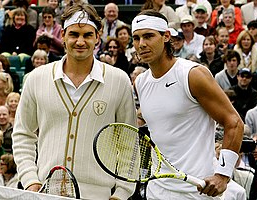 There has never, in the history of tennis, been a match as exciting and as tense as the Roger Federer versus Rafael Nadal match in 2008. Before the two even met, the crowds were already talking about the Fedal final.
There has never, in the history of tennis, been a match as exciting and as tense as the Roger Federer versus Rafael Nadal match in 2008. Before the two even met, the crowds were already talking about the Fedal final.
Last year, at the 2007 Wimbledon Championships, Roger Federer had edged out Rafael Nadal in five sets 7-6 (7), 4-6, 7-6 (3), 2-6, 6-2 to capture his fifth straight Wimbledon title. That final was exciting enough and had crowd on their feet the entire time.
No one thought that they could top off the 2007 Wimbledon final but the hype was there. Combined, the two only dropped one set on their road to the finals with Rafael Nadal only dropping one to Gulbis in the second round 5-7.
- Roger Federer himself took down many notable names such as Robin Soderling, former rival Lleyton Hewitt, and Marat Safin. Meanwhile, Rafael Nadal eliminated names like Mikhail Youzhny and Andy Murray.
When the two met in the final, there were talks of yet another action-packed “Fedal” matchup but no one expected it to be at the caliber of last year’s performance. But Roger Federer and Rafael Nadal quickly addressed those issues.
Lasting six hours total, the match was one that started out fast from the very first point. Not wanting to repeat last year’s loss, Rafael Nadal started out fast, clinching the first two sets 6-4 each. This was mainly due to the fact that Rafael Nadal was dominating from the baseline and Roger Federer was getting frustrated with his own shots.
Simply put, Rafael Nadal was controlling every single game of the first and second set.
Things began to look up for Roger in the third set, however. After a rain delay at 5-4 in Federer’s favor, the momentum began to take the Swiss player’s side. Despite a close few games, Federer quickly took advantage in the tiebreaker and won a mini break at 3-2 on Nadal’s serve.
He eventually extended this to a 5-2 lead that helped him close out the third set tiebreaker 7-5. Now, with Federer back in the match, things began to get much tenser. The two held back and forth once again to bring the fourth set to a tiebreak but this time, it was Nadal who came out swinging.
Nadal quickly secured a 5-2 lead thanks to his persistence and gritty baseline ability. However, Federer was able to match with a purely offensive game that tied the game to 5-5. He would then have his shot at closing the set when up 6-5 but a relentless string of forehands by Nadal eventually forced Federer to cave in and Nadal was presented with his first ever Championship point at 7-6 in his favor.
Federer wouldn’t let this go to waste. Now tied at 8-8, Roger quickly won the next two points off of capitalizing the errors of Nadal and would barely notch a second set to tie it at two sets a piece.
Now in the fifth set, the two would go at it again, holding for serve and passing the 6-6 match. But in Wimbledon format, there’s no fifth set tiebreak. You keep going. At seven games all, Federer was on serve to look to hold once more but this time, Nadal had different plans.
Despite Federer throwing everything he could at Nadal, Nadal responded with better every single time, carving up angles that Federer couldn’t reach. This finally gave him the break he needed after three saved break points by Federer to bring the Spaniard up 8-7.
The fifteenth game of the fifth set would be no less different. On Nadal’s serve, it quickly went to deuce but Nadal was able to secure his third Championship point after an unforced error by Federer. After an exchange of rallies, Federer would miss his approach shot into the net to secure Nadal’s first ever Wimbledon title.
This match wasn’t just the best match in the history of Wimbledon. This is ranked as the best match in the history of tennis by a majority of people from around the world. This was whenever the Swiss Maestro and the Spaniard Bull were at their best and were considered to be the two players that could play at a different caliber from the others.
Obviously, Rafael Nadal rules the clay courts and for Roger Federer, it’s the grass. But this match didn’t only have symbolism in the fact that it proved Nadal could play on more than one court and prove the critics wrong, it kept Federer from holding the record of most consecutive Wimbledon titles won.
In 2009, Federer would go on to win his sixth Wimbledon title and had Federer taken down Nadal in 2008, Federer would have created a legacy that would remain unbeaten for the years to come. There has never been a rivalry as intense as Federer vs. Nadal and this match proved why the “Fedal” feud is one of the most iconic in the sport of tennis.
Conclusion
We’ve seen our fair share of iconic matches in 2019 already and we’ve seen our fair share of iconic matches in the past. There’s the famous time Stanislas Wawrinka snatched a Roland Garros title away from Novak Djokovic.
There’s also the time that Roddick almost took another Wimbledon title away from Roger Federer. The matches are limitless and in the future, there are going to be more matches like these that deserve to be on the list.
With new talents on the rise every single year, there’s sure to be a new rivalry between the ages and a new group of elite tennis players. So, while it’s good to reflect on the matches of the past, it’s equally as exciting to see what the future of tennis holds in store for us.







